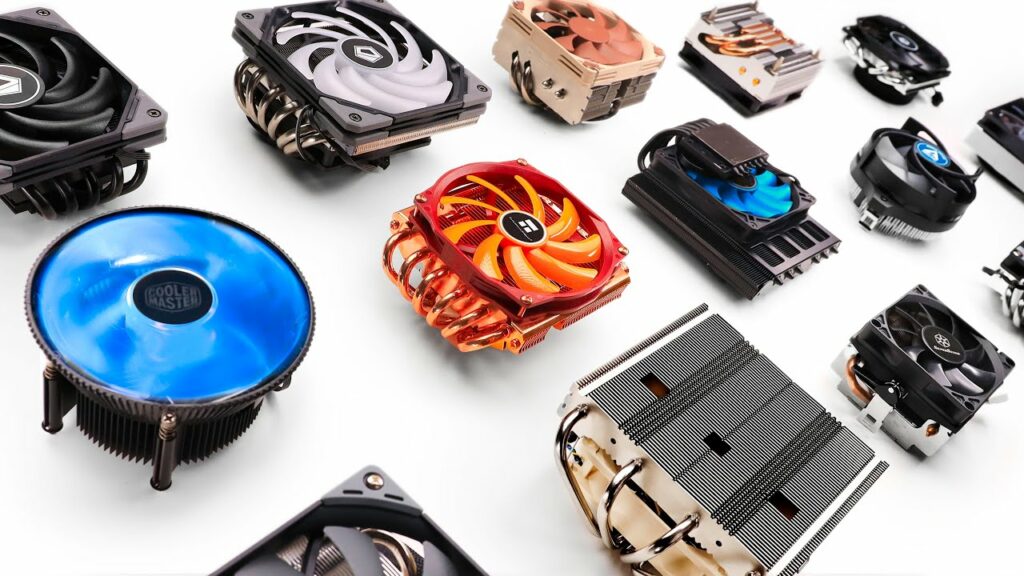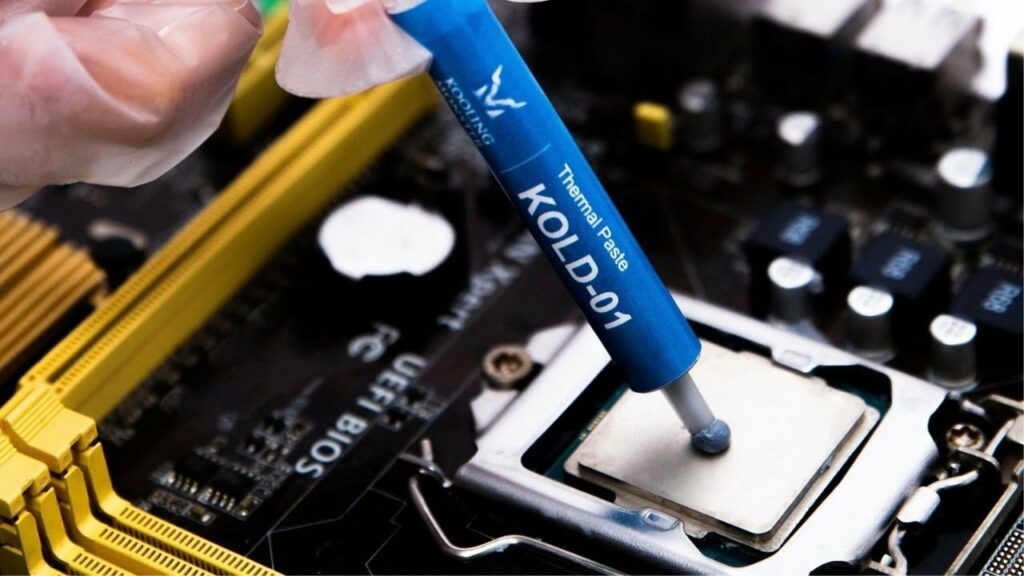When building or upgrading a PC, one of the critical components to consider is the CPU cooler.
Yes, CPU coolers often come with thermal paste included. Both AMD stock and some Intel coolers have pre-applied thermal paste for convenience. The thermal paste is typically included in the package when purchasing a cooling system.
In this article, we’ll explore the role of thermal paste in CPU cooling and whether CPU coolers come with thermal paste included.
What Is Thermal Paste?
Thermal paste, heat goo, or CPU jelly, is a sticky substance used in computers. It helps transfer heat between the CPU and its cooler.
This substance fills tiny gaps between the surfaces, making them snugly together. It’s like glue but for heat.
Thermal paste ensures the CPU doesn’t overheat by efficiently moving heat away. It’s crucial for the computer’s performance and longevity.
The CPU could get too hot without thermal paste and stop working correctly.
Is Pre-Applied Thermal Paste Good?

Pre-applied thermal paste is like having icing already on a cake. It’s convenient because it comes ready to use with the CPU cooler.
You don’t need to worry about applying it yourself. However, the quality can vary. Sometimes, the pre-applied paste might need to be of better quality. It could be too much or too little.
While it’s easy for beginners, some enthusiasts prefer to use their thermal paste for better performance. It’s a matter of personal preference and the specific needs of your computer.
See Also: How Tight Should CPU Cooler Be – Expert Tips On CPU Cooler!
Which Intel And AMD CPUs Come With Stock Coolers?
Intel and AMD CPUs often come with stock coolers in the box. These stock coolers are designed to provide adequate cooling for the CPU under normal operating conditions.
For Intel CPUs, the stock cooler is commonly referred to as the Intel stock cooler, while for AMD CPUs, it’s known as the AMD stock cooler.
These coolers vary depending on the specific CPU model and its thermal requirements.
Generally, lower-end CPUs are more likely to come with stock coolers, while higher-end models may require aftermarket cooling solutions for better performance.
Do Coolers And Fans Come With Thermal Paste?
Coolers and fans often include thermal paste, but it depends on the specific product and manufacturer. Some CPU coolers, especially budget or entry-level ones, may come with pre-applied thermal paste on the base.
This pre-applied paste can save users time and effort during installation. However, higher-end or aftermarket coolers may not include thermal paste, requiring users to purchase it separately.
It’s essential to check the product specifications or packaging to determine whether thermal paste is formed with the cooler or fan you’re considering buying.
Types of CPU Coolers

There are two central CPU cooler types: air and liquid.
1. Air coolers
Air coolers use fans and metal parts to keep the CPU cool. They’re usually cheaper and simpler to put in than liquid coolers.
2. Liquid coolers
Liquid coolers, sometimes called All-in-One (AIO) coolers, use liquid and a unique radiator to keep the CPU cool.
They work well and are great for people who push their computers hard, like gamers who play a lot of people who like to make their computers go faster than usual.
Factors To Consider When Choosing a CPU Cooler
- CPU Compatibility: Ensure the cooler is compatible with your CPU socket type. Different CPUs require specific coolers designed to fit their socket configuration.
- Cooling Performance: Consider the cooling performance of the cooler, especially if you have a high-performance CPU or plan to overclock. Look for coolers with larger heatsinks, more heat pipes, or additional fans for better cooling efficiency.
- Size and Clearance: Check the cooler’s dimensions to ensure it fits inside your computer case without obstructing other components like RAM modules or graphics cards. Make sure there is enough clearance for installation.
- Noise Levels: Pay attention to the noise levels generated by the cooler’s fans. Opt for coolers with quieter fan designs or adjustable fan speeds if noise concerns you.
- Type of Cooler: Decide whether you prefer an air or liquid cooler. Air coolers are typically more affordable and accessible to install, while liquid coolers offer superior cooling performance but may require more maintenance.
- Aesthetics: Consider the aesthetics of the cooler, especially if you have a windowed case or RGB lighting setup. Some coolers have customizable RGB lighting options to match your system’s aesthetics.
- Budget: Determine your budget for a CPU cooler and choose one that offers the best value for your money while meeting your cooling needs.
- Reviews and Recommendations: Research reviews and user feedback to gauge the performance and reliability of different CPU coolers. Consider recommendations from trusted sources or online communities for informed decision-making.
Considering these factors, you can select a CPU cooler that effectively dissipates heat from your CPU while fitting seamlessly into your system configuration.
Do CPUs Need Thermal Paste At All?

Yes, CPUs need thermal paste to ensure adequate heat transfer between the CPU and its cooler. With thermal paste, gaps and air pockets between the CPU and cooler would allow heat dissipation.
Thermal paste fills these gaps, facilitating efficient heat transfer and preventing overheating.
In short, thermal paste is crucial for maintaining optimal CPU temperatures and ensuring the longevity of the CPU.
See Also: CPU Vdd Soc Current Optimization – Optimize CPU Power!
Do AMD CPUs Come With Thermal Paste?
Yes, AMD CPUs typically have thermal paste pre-applied on the stock cooler. This pre-applied thermal paste ensures that users can install the CPU cooler without the hassle of applying the paste themselves.
It’s a convenient feature for those who want a straightforward installation process.
However, if users prefer to use aftermarket coolers or wish to apply their thermal paste, they can do so by cleaning off the pre-applied paste before installation.
Do Intel CPUs Come With Thermal Paste?
Yes, Intel CPUs usually have thermal paste pre-applied on the stock cooler. This pre-applied thermal paste simplifies the installation process for users as they don’t have to apply it themselves.
It’s a convenient feature, especially for beginners or those who prefer a hassle-free setup. However, if users opt for aftermarket coolers or want to use their thermal paste, they can clean off the pre-applied paste before installation.
How To Properly Apply Thermal Paste

To properly apply thermal paste, clean the CPU and cooler surfaces using a lint-free cloth and isopropyl alcohol.
Then, apply a small amount of thermal paste at the centre of the CPU. Next, carefully place the cooler onto the CPU and secure it.
Avoid using too much paste, as it can lead to overheating. Finally, ensure even paste coverage between the CPU and cooler for effective heat transfer.
Tips For Applying Thermal Paste Effectively
- Use a pea-sized amount: Apply a small drop of thermal paste onto the centre of the CPU to ensure even distribution.
- Clean surfaces: Before applying thermal paste, thoroughly clean the CPU and more excellent surfaces with isopropyl alcohol and a lint-free cloth to remove any debris or old paste.
- Avoid spreading manually: Let the pressure from the cooler spread the thermal paste naturally when installing it onto the CPU. Avoid applying it manually, as this can lead to uneven application.
- Follow manufacturer guidelines: Refer to the manufacturer’s instructions or guidelines for the specific thermal paste you use to ensure proper application technique and amount.
- Check for even spread: After installing the cooler, check for an even applied thermal paste between the CPU and cooler to ensure optimal heat transfer and cooling performance.
See Also: High CPU Temp On Startup – Fix Startup CPU Overheating Now!
Conclusion
Final Thought,
Thermal paste is essential for maintaining optimal CPU temperatures and ensuring efficient heat transfer between the CPU and its cooler.
Whether pre-applied or applied manually, thermal paste plays a crucial role in preventing overheating and prolonging the lifespan of the CPU.
Common Questions
1. Do Ryzen CPUs Come With Thermal Paste?
Yes, Ryzen CPUs typically come with pre-applied thermal paste on the stock cooler, making installation more accessible for users.
2. Do CPU Coolers Come With Thermal Paste?
Yes, many CPU coolers include thermal paste, either pre-applied or included separately in the package for user convenience.
3. Do Intel CPUs Come With Thermal Paste?
Yes, Intel CPUs usually come with pre-applied thermal paste on the stock cooler, simplifying the installation process for users.
4. Is Pre-Applied Thermal Paste Any Good?
Pre-applied thermal paste offers convenience but may vary in quality. While suitable for most users, enthusiasts may prefer using aftermarket thermal paste for better performance.
5. Do All CPU Coolers Come With Thermal Paste?
Not all CPU coolers come with thermal paste included. Some come with pre-applied thermal paste, while others require users to apply it separately.
6. Can I Reuse Thermal Paste?
Reusing thermal paste once it has been applied and removed is generally not recommended. Reapplying fresh thermal paste ensures optimal heat transfer.
7. Why AMD GPUs With Intel CPUs Can Be Ideal For Some Users?
AMD GPUs with Intel CPUs can be ideal for some users because they offer flexibility in component selection and potentially better performance in specific tasks due to optimized drivers. It can sometimes be more cost-effective than pairing an Intel CPU with an Nvidia GPU.
8. Can You Use AMD GPUs With Intel CPUs?
Yes, you can use AMD GPUs with Intel CPUs. They are compatible and can work together seamlessly in a computer system.
9. Do Amd Graphics Cards Work With Intel?
Yes, AMD graphics cards are compatible with Intel processors, allowing users to pair them together in a computer system.
Also Read
- CPU Ratio Offset When Running AVX – Optimize AVX Efficiency!
- Is 80c Safe For CPU – Check CPU Temperature For Safety!
- Can I Use 70 Isopropyl Alcohol To Clean CPU – Find Out How!

Hi everyone, Johns Jack here, your approachable tech aficionado! I’m passionate about CPUs and thrive on keeping up with the newest tech developments. Join me as we delve into the dynamic realm of technology! Visit: Techy Impacts

